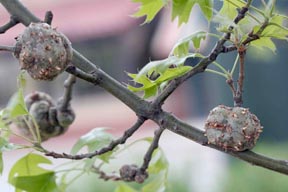Oak Galls | |
|---|---|
| May 15, 2007 | |
|
Insect-caused oak galls appear as unusual growths or deformities on leaves, twigs, flower, buds, bark, stems, and even acorns and roots. Most galls are harmless to trees. However, in Illinois, both the horned and gouty oak galls can be debilitating and even kill younger trees. In recent years, these two types of galls have been increasingly present in the southern third of Illinois. Oak galls are caused by a group of small insects known as gall akers. Galls are a part of the insectís reproductive cycle and provide a protected enclosure for development of offspring (larvae). The gall is formed by the tree in reaction to insect-released chemicals or other stimulus, which incite plant hormones to form the gall. The inside of the gall is rich with protein and provides a source of concentrated food for the developing larvae. The types of galls and the insects causing them are specific to various types of oak. Some galls are round or lumpy, some spiny, other flattened and dish-shaped. Sizes can range from a fraction of an inch to several inches in diameter. Often the larger galls grow together on stems, forming large masses that weigh the branch down. The majority of gall makers are tiny wasps, though some are fly species. There have been over 700 species of gall wasps documented in North America. However, proper identification of these species has been challenging for insect taxonomists. The wasp gall makers are unique in that they can have different body structures depending on the generation, which along with a complex life cycle has confused their identification. Each species causes a distinctive type of gall on a specific plant part. Interestingly, for some species, this habit skips a generation, with the offspring forming a differently shaped gall on a different plant part, similar to its grandparents and not like its parent. The gall maker life cycle involves egg laying on the plant and larvae development occurring within the confines of the gall. Compared to that of other insects, the life cycle is complicated. For example, with horned oak gall, an all-female generation emerges in the spring from old galls, and they lay eggs on leaves. A leaf gall is formed; the larvae develop; and within a few months, male and female adults emerge and mate. The females then lay eggs on twigs, the larvae hatch and bore into the stem. By the next spring, small, new galls of this generation appear, and the galls grow slowly as the larvae develop. Two or more years are required for this all-female generation to hatch and begin the cycle again.  In southern Illinois, the most noticeable and important oak galls are the horned and gouty oak gall, caused by two closely related wasp species (Callirhytis spp.). These galls are also seen more sporadically in central and northern Illinois, being most common on newly transplanted trees from more southern sources. Horned oak gall occurs on pin, black, and water oak, while gouty oak gall occurs on pin, scarlet, red, and black oak species. Approaches to managing these two oak galls are limited at best. For younger trees, it is possible to trim the affected twigs and branches out. This is more difficult on larger trees unless done by a commercial arborist with a lift truck. Affected trees can be fertilized to encourage healthy growth, with mid to late fall being the best time to apply. Keep in mind that the galls are live tissue and are part of the twig. Larvae within the galls cannot be reached by insecticides or oil sprays, even systemics. Because adults emerge at various times in the spring and midsummer to lay eggs on leaves or twigs, it is difficult to effectively time sprays, which may also have limited residual effect. In addition, because these are wasp species, many insecticides are not effective or labeled for them. Thus, using chemical insecticides that target eggs, larvae, and adults is a limited control approach. Systemic insecticides with the active ingredient imidacloprid (Merit) may affect feeding larvae before galls are fully formed, though research is inconclusive. We would be interested in reports of any observed or measured results of insecticide application for gall control. Some of the earlier botanists in North America believed galls were simply a typical structure of a normal plant. To many, these galls are unsightly, but they are a part of the natural system associated with oak species that we have in the landscape. As part of the natural system, there will be high and low population cycles of gall-maker insects; and perhaps in a few years, these galls will be less prevalent than they are now. An excellent reference from which this article was adapted is Insects that Feed on Trees and Shrubs by Johnson and Lyon (Cornell University Press). To identify galls, probably the best references are Plant Galls and Gall-Makers by E.P. Felt (Hafner Press) and The Plant-Feeding Gall Midges of North America by R.J. Gagne (Cornell Universtiy Press). Unfortunately, Feltís book has been out of print for at least 25 years, and almost all oak galls are caused by gall wasps, not midges. (Tony Bratsch, Extension Educator, Horticulture; and Phil Nixon) |